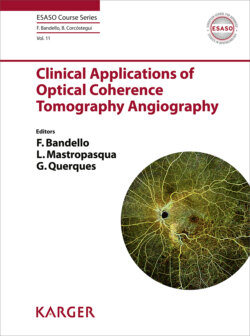Читать книгу Clinical Applications of Optical Coherence Tomography Angiography - Группа авторов - Страница 24
На сайте Литреса книга снята с продажи.
Clinical and Traditional Imaging Features of Radiation Retinopathy
ОглавлениеGlobe-sparing treatment of choroidal melanoma through various forms of radiation results in excellent tumor control, but not without consequences [63–65]. Gunduz et al. [66] studied 1,300 eyes with uveal melanoma treated with plaque radiotherapy and found 42% developed radiation retinopathy at 5 years leading to loss of vision. The mechanism of radiation retinopathy likely involves increased inflammatory cytokines, notably VEGF, since prophylactic intravitreal injections of the anti-VEGF agent bevacizumab results in a reduction of radiation complications [67]. Clinically, radiation retinopathy can manifest in non-proliferative and proliferative forms, similar to diabetic retinopathy [64–72]. Non-proliferative radiation retinopathy appears as nerve fiber layer infarcts (cotton wool spots), microaneurysms, intraretinal hemorrhages, hard exudates, and CME [65–69]. Proliferative radiation retinopathy, on the other hand, is characterized by either preretinal neovascularization resulting in preretinal or vitreous hemorrhage or iris neovascularization resulting in neovascular glaucoma [64–66, 70–72].
Among imaging modalities relevant to the evaluation and management of radiation retinopathy, IVFA and OCT are arguably the most important. IVFA allows evaluation of FAZ, documentation of non-perfusion or points of leakage in the macula for laser treatment planning, and even grading of radiation retinopathy with ultra-wide-field angiography [18, 71]. On the other hand, OCT is useful in grading the severity of macular edema and is critical in the early detection of radiation maculopathy. Horgan et. al. [27] studied 135 eyes that had plaque radiotherapy for uveal melanoma and found that the mean time to onset of OCT-evident macular edema was 12 months, with some occurring as early as 4 months post-radiation. Furthermore, OCT resulted in the identification of more cases of macular edema (61 vs. 38%) at a much earlier time point after radiation (12 vs. 17 months) compared to clinical evaluation [27]. Similar to the management of diabetic retinopathy, OCT has also become the de facto imaging device used to guide therapy in radiation-related macular edema given its reproducibility and efficiency [73, 74].
